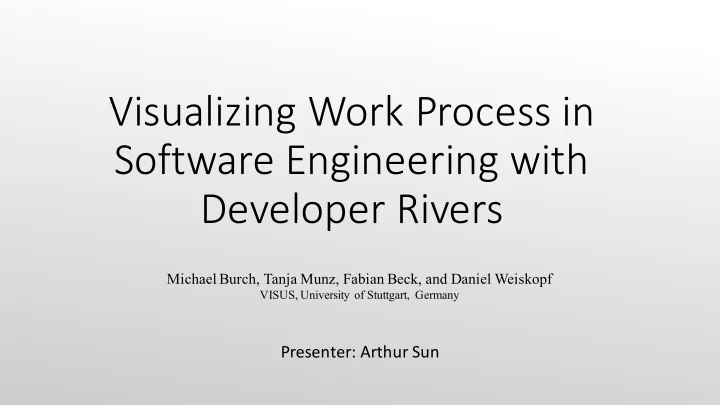

Visualizing Work Process in Software Engineering with Developer Rivers Michael Burch, Tanja Munz, Fabian Beck, and Daniel Weiskopf VISUS, University of Stuttgart, Germany Presenter: Arthur Sun
Outline • What’s the current problem for large software projects • What’s the previous solution for large projects InfoVis • What the paper presents • DataSet • InfoVis Encoding Technique • Visualization Method • Sample Usage • Future Improvement
Large open-source projects: 560, 560,519 519 commits
Large open-source projects: 5659 5659 contributors
Large open-source projects: 441 441 releases
What’s do we want A whole picture of the overall progress of extreme large software engineering project proceeding with time frame in detailed visualization for major participants, their contribution to respective work, how much amount of work they did and their work change
Previous work – Sankey Diagram Sankey diagrams are a specific type of flow diagram, in which the width of the arrows is shown proportionally to the flow quantity. Problem: No Time Frame
Previous work – Gantt Chart A Gantt chart is a type of bar chart that illustrates a project schedule. Gantt charts illustrate the start and finish dates of the involved tasks. Modern Gantt charts also show the dependency Problem: 1. Doesn’t show how many people/resources involved in project 2. Don’t have a whole picture about the project
What’s the author propose • A graph flow which can not only show the interconnection of different modules of development along with the timeframe but also the programmer who took part in the whole project with vivid color to show difference
Visualization Technique DataSet: Developer Activity Model Encoding:Develop River for Time-Varying Developer Activities
Dataset: Developer Activity Model 1. Abstract commit as c, time as t, developer name as d, files as f, all files as F, file modules hierarchy as H Partition sequence of commits into equally-sized intervals for each interval of commits and every module Calculate individual developer activity of their files for each module and reach module specific developer activity Calculate weighted transition matrix for each developer Mi = Mat((l+1)*(l+1)) Calculate the weighted transition matrix for all developers by summing up Mi Pa Paper di didn’ dn’t sh show ho how to to ma map re real da data in into Ac Activity Mo Model Ma Matri rix
Developer Rivers Ma Mapping Activity Mo Model Ma Matri rix into Develop Ri Rivers wi without intersection
Developer Rivers Ma Mapping Activity Mo Model Ma Matri rix into Develop Ri Rivers with intersection
Developer Rivers Curves 1. Transition: how developers change their behavior between different module groups using cubic Bezier Curves 2. Transition color is a linear gradient from color of start module to target module Pa Paper di didn’ dn’t sh show ho how to to lin link Ma Matri rix Dat ata wi with Be Bezier cu curve cr creation Influents Effluents Developer join current step Level the main river
Developer Rivers Curves Effluents Effluents Leave the main river Leave the main river
Diagram • Inflow/Outflow: A transition from or to the outside of the diagram identifies a developer enter or leaving the project • Constant Flow: An intra-transition with a constant width indicating a group of developers constantly working on the same module • Growth/Decline: An intra-transition with an increasing or decreasing strength hints at a group of developers that keep working on a module but with changing total effort • Split/Merge: A module that is split into or merged from multiple flows shows a qualitative change of developer activity (i.e., developers’ relative focus switches between modules). While at least one inter-transition is required for this pattern, one of the flows can be an intra-transition. • Exchange: A pair of intra-transitions connecting two modules in opposite directions at the same time is a specific qualitative change of activity: some developers move between the two modules in both directions.
#developers Constant Flow Merge Growth Inflow Exchange drivers fs arch kernel net Documentation 2013 2006 2007 2008 2009 2010 2011 2012 Fig. 8. Linux main module overview , 2006–2013, 1-year interval.
Visual Patterns • Main Module Overview • Consists main directories, developers and their contributors • File Type Overview • Automatic definition of modules by file types • Developer Sparklines • Highlight top 5 star developer contributing most to the whole project • Subsystem Details • Modules in a subdirectory of the system shows details of a specific system
Lib Modules Doc Tools 1991 – 1992 1992 – 1993 1994 – 1995 1996 – 1997 1999 – 2000 Python main module overview
Lib Modules Doc Tools 1. Guido van Rossum 2. Georg Brandl 3. Fred Drake 4. Benjamin Peterson 5. Jack Jansen 1995 2000 2005 2010 Python Developer Sparkline of top 5 developers
1997 – 2001 2002 – 2006 2007 – 2011 Python Subsystem details of Tools Directory
1991 – 1993 1994 – 1996 1997 – 1999 2000 – 2002 2003 – 2005 2006 – 2008 2009 – 2011 Fig. 4. Python file type overview , 1991–2011, 3-years interval. Python file type overview
Linux Developer Sparkline of top 5 developers
Linux Subsystem details of Tools Directory
Future Improvements • Show us how do the author organize the data(Data->Matrix) • Show how to transfer the data into influents and effluents (Matrix- >Influents) • Provide tool ready for practitioners who can use developer river directly(No description about how to tackle the dataset) • Distinguished colors may be up to 10 colors, otherwise graph may be hard to see • Transfer the way to study software engineering research into social- technical aspects of engineering research
Recommend
More recommend